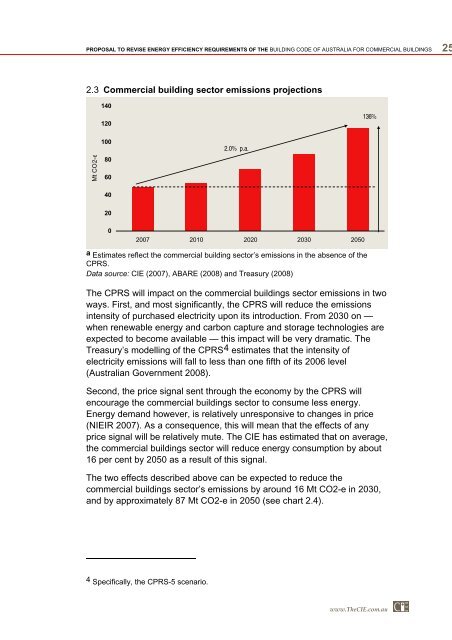PDF | 2 MB - Australian Building Codes Board
PDF | 2 MB - Australian Building Codes Board
PDF | 2 MB - Australian Building Codes Board
You also want an ePaper? Increase the reach of your titles
YUMPU automatically turns print PDFs into web optimized ePapers that Google loves.
PROPOSAL TO REVISE ENERGY EFFICIENCY REQUIREMENTS OF THE BUILDING CODE OF AUSTRALIA FOR COMMERCIAL BUILDINGS 25<br />
2.3 Commercial building sector emissions projections<br />
140<br />
120<br />
136%<br />
Mt CO2-e<br />
100<br />
80<br />
60<br />
2.0% p.a.<br />
40<br />
20<br />
0<br />
2007 2010 2020 2030 2050<br />
a Estimates reflect the commercial building sector’s emissions in the absence of the <br />
CPRS. <br />
Data source: CIE (2007), ABARE (2008) and Treasury (2008) <br />
The CPRS will impact on the commercial buildings sector emissions in two<br />
ways. First, and most significantly, the CPRS will reduce the emissions<br />
intensity of purchased electricity upon its introduction. From 2030 on —<br />
when renewable energy and carbon capture and storage technologies are<br />
expected to become available — this impact will be very dramatic. The<br />
Treasury’s modelling of the CPRS 4 estimates that the intensity of<br />
electricity emissions will fall to less than one fifth of its 2006 level<br />
(<strong>Australian</strong> Government 2008).<br />
Second, the price signal sent through the economy by the CPRS will<br />
encourage the commercial buildings sector to consume less energy.<br />
Energy demand however, is relatively unresponsive to changes in price<br />
(NIEIR 2007). As a consequence, this will mean that the effects of any<br />
price signal will be relatively mute. The CIE has estimated that on average,<br />
the commercial buildings sector will reduce energy consumption by about<br />
16 per cent by 2050 as a result of this signal.<br />
The two effects described above can be expected to reduce the<br />
commercial buildings sector’s emissions by around 16 Mt CO2-e in 2030,<br />
and by approximately 87 Mt CO2-e in 2050 (see chart 2.4).<br />
4 Specifically, the CPRS-5 scenario.<br />
www.TheCIE.com.au
















